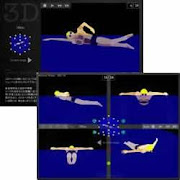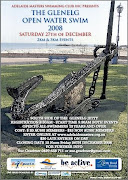 In a recent article in the Sydney Morning Herald, Steve Meacham writes about racing etiquette and high-tech swim suits.
In a recent article in the Sydney Morning Herald, Steve Meacham writes about racing etiquette and high-tech swim suits. His article touched on the debate among swimmers in the build-up to the Big Swim in Sydney, Australia.
His article touched on the debate among swimmers in the build-up to the Big Swim in Sydney, Australia. The open water swimming community is debating if competitors should be allowed to swim in the latest high-tech suits. But, the Big Swim enthusiasts delve even deeper into more fundamental issues: Is it acceptable for faster swimmers to swim over the top of slower competitors? Should race organizers police antisocial behavior especially around the turn buoys?
The open water swimming community is debating if competitors should be allowed to swim in the latest high-tech suits. But, the Big Swim enthusiasts delve even deeper into more fundamental issues: Is it acceptable for faster swimmers to swim over the top of slower competitors? Should race organizers police antisocial behavior especially around the turn buoys? Because our sport is growing FAST all over the world attracting people of all ages and abilities to events in every kind of water, we will inevitably run up against various issues. Fortunately, the sport, its rules, its equipment, its training methodologies, its timing technology, its national and international infrastructure and its athletes are continuously evolving … for the better.
Because our sport is growing FAST all over the world attracting people of all ages and abilities to events in every kind of water, we will inevitably run up against various issues. Fortunately, the sport, its rules, its equipment, its training methodologies, its timing technology, its national and international infrastructure and its athletes are continuously evolving … for the better. To use an open water analogy, we may be swimming in a bit of rough water now, but the currents are strongly in our favor.
To use an open water analogy, we may be swimming in a bit of rough water now, but the currents are strongly in our favor.This year, the Big Swim organizers leveled the playing field by forcing swimmers to wear conventional swim suits. The organizers decided that the swim suits must contain no neoprene or any other 'high-tech' material or any material with any flotation support. The male suits cannot cover any part of their body above the waist and female suits cannot cover their arms or legs.
 This decision eliminated the use of blueseventy, Speedo, TYR and other high-tech swim suits to the satisfaction of purists.
This decision eliminated the use of blueseventy, Speedo, TYR and other high-tech swim suits to the satisfaction of purists.For those who did make the investment in a high-tech suit, they may be disappointed. From our perspective, a better alternative is to offer a 'high-tech' race and a 'traditional' race for the competitors.
We say: double the fun, don't half the alternatives.
Unlike pool swimming which is limited to 8 people racing in rectangular chlorinated pools with lines, lanes and controlled water temperature, open water swimming venues and competitions are only limited by the creativity of race directors and the desires of swimmers.
 It is our belief – backed by observations and economic reality – that open water swimmers – both newcomers and veterans – will continue to demand and purchase a variety of high-tech suits, wetsuits and all kinds of new products that have yet to be designed or manufactured.
It is our belief – backed by observations and economic reality – that open water swimmers – both newcomers and veterans – will continue to demand and purchase a variety of high-tech suits, wetsuits and all kinds of new products that have yet to be designed or manufactured. While many people enjoy open water swimming primarily for the challenge of finishing and the camaraderie of the sport, many others like to push themselves to see how fast they can swim – whether it is a race against others or as a comparison to their previous performance.
 While we understand and greatly appreciate swimming in nothing but a traditional swim suit and goggles, we also understand why many people enjoy the speed and performance enhancement they feel in a high-tech suit.
While we understand and greatly appreciate swimming in nothing but a traditional swim suit and goggles, we also understand why many people enjoy the speed and performance enhancement they feel in a high-tech suit. While we understand the sense of fairness and establishing a level playing field, we also wonder think that if high-tech suits are allowable in the pool, then they should also be allowed in open water events.
While we understand the high-tech suits are costly and not everyone can afford them, we also think that a more restrictive policy is not optimal in a sport that is growing and attracting new enthusiasts every day.
While we understand and appreciate the challenge of swimming in cold water, and learning how to swim properly without having the advantages of high-tech suits, we also greatly appreciate the financial support the new high-tech suit manufacturers have provided to the sport.
 Isn't it better to keep both sides of the debate happy? From Hong Kong to Helsinki, many races have a 'wetsuit' and a 'non-wetsuit' division. Give more awards – not fewer – and keep more swimmers happy.
Isn't it better to keep both sides of the debate happy? From Hong Kong to Helsinki, many races have a 'wetsuit' and a 'non-wetsuit' division. Give more awards – not fewer – and keep more swimmers happy. Perhaps another alternative is to establish a new award category With contemporary timing systems, it is easy to compare the times of the 'high-tech' swimmers versus the 'traditional' swimmers. To create a little buzz, race directors can handicap the competitors.
Perhaps another alternative is to establish a new award category With contemporary timing systems, it is easy to compare the times of the 'high-tech' swimmers versus the 'traditional' swimmers. To create a little buzz, race directors can handicap the competitors. That is, if the average time of high-tech swimmers from the previous year is 90 seconds faster than the times of traditional swimmers, then the high-tech swimmers can be handicapped by 90 seconds. See who 'wins' the race and give that swimmer a special award.
 In any case, the Big Swim has made its decision. Some people are happy; some are not; and others are indifferent. Swimmers can now swim mano-a-mano under traditional rules competing for the same prizes. We applaud the decision-makers.
In any case, the Big Swim has made its decision. Some people are happy; some are not; and others are indifferent. Swimmers can now swim mano-a-mano under traditional rules competing for the same prizes. We applaud the decision-makers. On the other hand, we believe open water swimming is extremely enjoyable for a rapidly increasing number of individuals. Not only are there race directors who see the value in allowing high-tech suits, but there are also many newcomers and veterans who enjoy racing in a high-tech suit.
In summary, we believe the demand for fast suits and new technology will continue at an unrelenting pace while purists can still enjoy the sport in the manner they see fit.
The evolution of the sport is good for all.




















3 comments:
To add to the debate. To those who look down upon us who use wetsuits I say chill out. I live on an estuary in Maine and right now the water temp. in the creeks is in the upper 20s. It's January, but I still swim 5 days a week 3 hours at a time. I can swim in comfort in ice water using a wetsuit. My racing days are over, but I still love to dwell in the water, swim with the seals and pray. For all of you swimmers in a big race or rush, take the time to see what's around you and on the bottom. Peace gary sredzienski http://www.youtube.com/watch?v=x8iFI__S7Ts
Re: the Big Shoulders 2.5/5K in Chicago:
1. They offer a wet suit division, though the water is only in the 70s or high 60s (F).
2. Since the course is either 1 or 2 2.5 km laps, there aren't that many problems with faster swimmers "swimming over" slower ones, though you sometimes see that due to the "wave start" which starts the 35 year old group 5 minutes after the 30 and under, then the masters 5 minutes after that, then the wet suits and others 5 minutes after.
I'm pretty slow but I've never been beat up; I'd say that this race is currently friendly for the fleet and the slow alike.
Chicago is certainly swimmer-friendly. We hear the organizers of the Big Shoulders 2.5K and 5K race go out of their way to make their race enjoyable to all.
On a separate, but related, subject, we understand Chicago is one of the frontrunners (if not the frontrunner) for the 2016 Olympics bid. If Chicago wins its Olympic bid, then the Big Shoulders 5K organizers will have something very important to do during the Olympic 10K Marathon Swim in Chicago...
Post a Comment